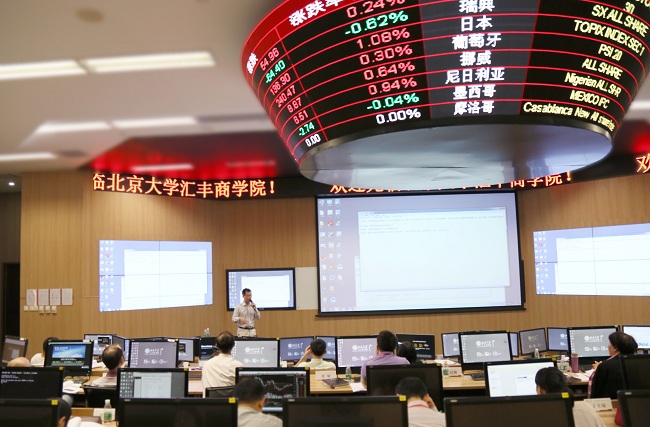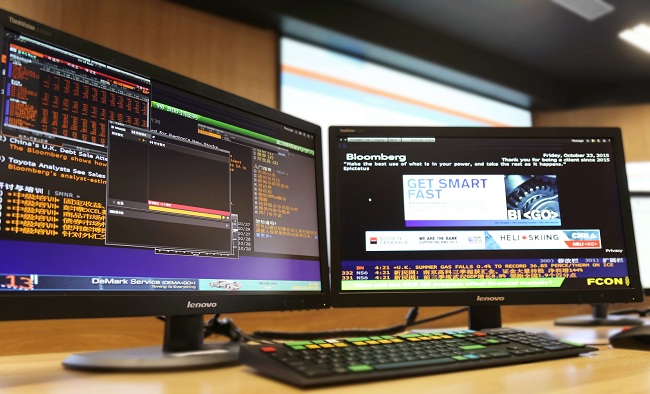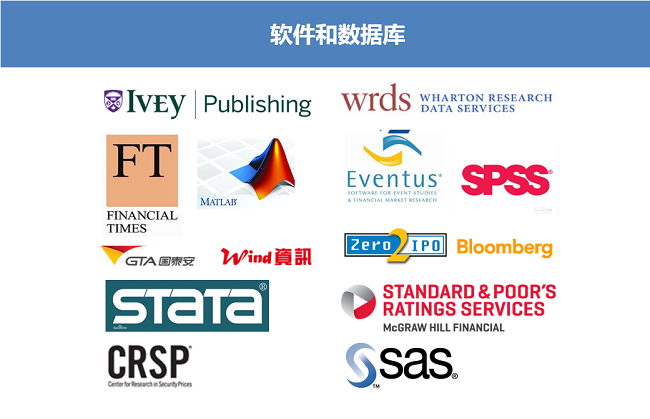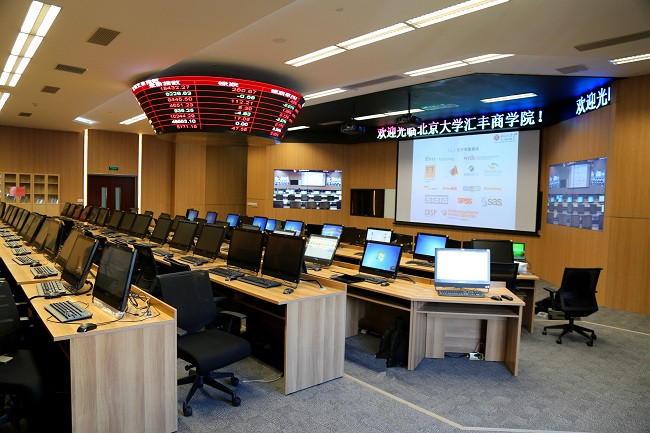In a world where markets are changing rapidly and big data is expanding, Peking University HSBC Business School opened its new financial lab in September 2015 to support faculty and student research. The financial lab is part of PHBS’s efforts to build an international campus to educate future business leaders with a global mindset and insight about China.

LED stock ticker
The 211 squire meters financial lab in PHBS 513 can accommodate up to 60 simultaneous users at its 60 computer terminals. An LED stock ticker is arranged in the center of the ceiling to provide a real-time data feed from all major stock exchanges, such as the New York Stock Exchange, the European Exchanges, and the Hong Kong Stock Exchange. A bar-shaped LED display showing news and data from global markets hangs on the wall over the platform.

Bloomberg terminal
In addition to the data displays, students can get both real-time and historical data about financial markets around the world through the 12 Bloomberg terminals, which are rare, even in a securities company, for instance, due to high price. Other terminals like Wind terminals are also provided.

Software and databases
The lab also has WRDS (Wharton Research Data Services), a platform from which many databases can be operated. It provides users with real-time quotes, historical data, price information, trade information, financial news, macroeconomic data, industry data, research literature, and more.
According to PHBS Professor Yu Zhou, the financial lab director, the school spends over one million yuan on databases and software. Data processing software including Matlab, SPSS, Stata and SAS was installed to help researchers analyze the data obtained from the databases, so they can practice and experiment with their ideas.
“Before we had this lab, our faculty and students had to line up to download the data they needed for papers from the only Bloomberg terminal in our old lab, copy the data to their personal computers, and then install the necessary software, and finally analyze the data,” Zhou said. “Now they can come to this new lab to enjoy the one-stop service. They can download data more easily and analyze the data by using the software installed in the computers to obtain preliminary results.”
PHBS Assistant Dean and Director of the MBA Program, Professor Wei Cen added that courses will be designed to encourage students to make most of the facility since the new lab provides students with hands-on training in a simulated real-market environment. Students can experience real-market operations through practical training and gain a better understanding of trading under the supervision of teachers, effectively bridging theory and practice.

Financial Lab
The lab also includes high-definition display screens, a live broadcasting system, a cloud server, a teacher’s terminal, 59 student computers, data processing software and other equipment for an interactive teaching system which connects the teacher, students, teaching content, and teaching equipment into a whole. The system allows the teacher and students to interact more than before since students can forward questions to the teacher’s terminal which can be seen instantly.
“In the future, some courses like derivatives of financial markets can be taught in the financial lab. Teachers can make use of the facilities to explain to students how to design and trade a financial product and how high-frequency data actually changes,” Zhou said.
Remote teaching has also become possible since the lab is equipped with a live broadcasting system and a cloud server where data can be stored.
From Monday to Friday, the financial lab is open from 9:00 a.m. to 12:00 p.m. and from 1:30 p.m. to 5:30 p.m. Daily service and management of the lab is supported by the Financial Lab Association, whose student members provide help when users have any problem related to the databases and software. To help users get to know the facilities well, a series of lectures about databases was designed by the financial lab and the Financial Lab Association. Lectures were held in the lab in November and December last year, and other lectures are forthcoming.
The financial lab also plays a role in training. In November 2015 the Training Program for Quantitative Investing with Global Vision was held, and experts in quantitative investment used the lab to do quantitative investment case studies with trainees in the investment field. The training was aimed to help participants better understand the financial markets and improve their competence in quantitative investment.
Referring to the development of the financial lab, Zhou said, “The school wishes to get strategic cooperation with leading data providers at all levels, share resources, and together promote talent cultivation and academic research.” Currently, GTA, a leading data provider in China, provides technical support for the software and hardware in the financial lab.
By Sheryl Shao
Edited by Priscilla Young








 Financial Lab
Financial Lab








